|
JOINT COMMISSION WORKING GROUP ON
UNDER-REPRESENTED GROUPS IN SURVEYING
 Visit the Web site of the
FIG Working Group on Under-represented Groups in Surveying
Visit the Web site of the
FIG Working Group on Under-represented Groups in Surveying
 This Newsletter in -pdf-format
This Newsletter in -pdf-format
Contents
Report: Workshop - Network on Under-represented
Groups in Surveying by Gabriele Dasse
How to get more students involved in FIG by
Linnéa Lindqvist and Jennie Nilsson, Sweden
The Women in Greece – Working and Developing
the Surveying Profession by Eleni Tziortzioti and Anna
Karagiannaki, Greece
Collaboration with Gender and Cartography
Commission by Gabriele Dasse
American Accreditation Board Strives for
Diversity by Wendy J. W. Straight, United States
Elizabeth Ann Johnson was a Leader in Diversity
contributed by Dr. Herbert Stoughton, United States
Report: Workshop - Network on
Under-represented Groups in Surveying
By Gabriele Dasse
The Joint Commission Working Group on Under-represented Groups in
Surveying organized a workshop during the FIG Working Week in Athens this
year in May, which was well attended. Three presentations were given from
Ali Buxton and Pat Turell (United Kingdom), Gabriele
Dasse (Germany) and Eleni Tziortzioti (Greece). Unfortunately
Sara Wilkinson (United Kingdom) and Anna Karagiannaki
(Greece) could not attend the workshop. Started with these presentations
the workshop produced an interesting debate and discussion. Many thanks
for the presentations, to Boo Lilje as rapporteur and to the
participants for their questions and statements.
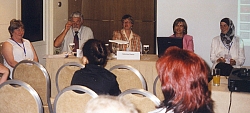
During the discussion (from left):
Pat Turell, Boo Lilje,
Gabriele Dasse, Eleni
Tziortzioti and Ali Buxton
During the afternoon session concerning young surveyors, Linnéa
Lindqvist and Jennie Nilsson presented their paper.
Summaries of the papers will be published in this issue and the next
one.
Meetings with FIG President Holger Magel and Vice-President
Bettina Petzold during the working Week resulted in deliberations to
draw up FIG guidelines to improve the situation of women, young surveyors,
like students, and cultural and language minorities. A draft should be
presented and discussed during the Working Week 2005 in Cairo.
Gabriele Dasse
e-mail: g.dasse@gmx.de
How to get more students involved in FIG
By Linnéa Lindqvist and Jennie Nilsson, Sweden
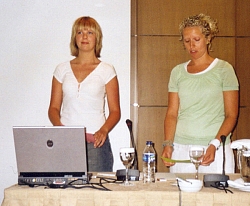
Jennie Nilsson (left) and Linnéa Lindqvist presenting in
Athens
The purpose with this article is to challenge FIG to work harder with
the question how to involve more students in the organization. We will
handle the topic in this article from a student perspective; what could be
done and how should the proposal be implemented?
Last year we attended the FIG working week in Paris. During the
conference we joined a session about underrepresented groups in FIG, held
by Gabriele Dasse. During the session we discussed the problem that
there are few female surveyors, few students and few surveyors from
distant countries who are participating in these global meetings.
We talked a lot about the lack of representatives of the surveyors of
the next generation; more students should participate during these
conferences. This is a topic that has been discussed in FIG for several
years, but no solution is yet to come. Without active participation of the
next generation there is no future for any profession connected to the
organization. It was during the discussion with Gabriele Dasse, since we
are students, the question came into our minds; how can we get more
students involved in FIG?
Why students are important in FIG
FIG represents an important international perspective of the Survey
profession. It is important for students to get a connection to the
organization and this international point of view in an early stage of the
studies. A connection to FIG brings a possibility for the student to get
an international commitment, a chance to meet people of the same age in
the same situation and a chance to meet experienced colleagues. A
gathering of students connected to FIG would be the beginning for the next
generation of Surveyors to get a social network with personal contacts. It
will also bring a chance to meet new friends and future fellow workers.
Another aspect of the meetings between students from different
countries is the possibility with exchange studies. It is easier to
establish a contact with a University abroad if you already have a
personal contact there. The experience of exchange studies brings personal
development and understanding for different cultures, which are important
in the forthcoming work as a surveyor. Therefore, FIG should work to
promote international co-operation also for the students.
Moreover, to let survey-students join the working week is a stimulant
to FIG and brings important rejuvenation to the organization. Active
participation of the next generation in FIG is very important for the
future for all professions connected to the organization. Students
involved in FIG do not meet all the needs of today, but they will meet and
develop the challenges of tomorrow.
How to implement the proposal
Students seldom have the possibility to finance the participation in
the Working Weeks. Some kind of sponsoring is necessary for the students
to be able to join the gatherings. One way to make this happen is if FIG
supplies students with Scholarships. However, FIG already has student
discounts on the membership fee and Scholarships for surveyors from
distant countries. A more reasonable possibility is if member-organisations
of FIG could sponsor students from the specific country. It is in their
interest that a Surveyor of the future has a width in her approach to
the forthcoming profession.
Another way for students to take part in FIG is to get the
Universities interested. The Universities could arrange suitable
contests to find interested students, and sponsor their participation at
the working week. To sponsor a student is a great chance for both the
University and for the specific student. The student becomes an
ambassador for the University, which leads to great advertisement.
To get the attention from the universities, a well organized
co-operation between the specific University and a contact connected to
FIG has to be established. The responsibility for the co-operation
should be in the hands of FIG and our proposal is to create a sub-group.
This sub-group could be a part of commission 2 - Professional Education.
It is important with a well organized forum to maintain the regularity
in the work with establishing students in FIG since you are a student in
a limited time. The sub-group could be the link between FIG and the
worldwide students.
Another way of helping students to be part of FIG is if experienced
members stand by students and become some kind of mentor. This
mentorship would lead to pleasure for both the mentor and the student
since they both can inspire each other. The student will come with new
ideas from an educational perspective while the Surveyor inspires the
student with knowledge and experience. The mentor and the student could
have their contact during the year via e-mail for example and then meet
in the Working Week.
It is a possibility for all local Survey students when a Working Week
takes place in their home country. Many more students have the chance to
participate as it does not demand as much funds to get to the conference
when it is nearby. FIG could help those students with the experience and
pleasure that rely in task of welcoming foreign students.
At the working week there can be a smaller session where the students
have an opportunity to talk about their experiences, differences between
their educations and the possibilities to exchange studies. These
discussions may serve as the basis of a further discussion in the home
country of the student.
Conclusion
In our future profession as surveyors it is important to have
international contacts as the countries of the world works differently.
There is much knowledge in different areas that can be shared if
international contacts are established on an educational level. Today
there is a lack of students involved in FIG, which prevents new ideas from
young people.
A sub-group for students in FIG and a co-operation between FIG and
Survey Programs all over the world would give many young people the great
experience that participation at a Working Week gives. A student
organization could be the beginning of a social network with personal
contacts and a chance to meet new friends and colleagues from all over the
world for both students and veterans.
Linnéa Lindqvist, Jennie Nilsson; Students at the Survey Program at
Lund Technical University
e-mail: linnea.lindqvist@telia.com,
jennie@hl.lu.se
The Women in Greece – Working and
Developing the Surveying Profession
By Eleni Tziortzioti and Anna Karagiannaki, Greece
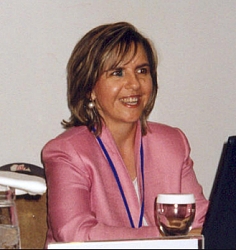
Eleni Tziortzioti during her presentation in Athens
1. Introduction
Greece is one of the countries that the majority of the students in
surveying field is still male, the same as it is at the professional
level. Last years, the statistic numbers prove that something happened
which gave very good reason to female candidates to choose that field of
studies. There were no activities by governmental or non-governmental
organizations that they tried to encourage in this direction. Changes
became by themselves, as the definition of surveyor engineer for the Greek
inhabitants seems to be more attractive as he is the engineer who uses
mostly new technologies and also has very low percentage of unemployed. It
is also very common to meet Greek women surveyors that they are very
successful professionals.
2. Female Surveyors through the Years
In Greece there is a big number of university-educated citizens in
proportion to the population. Surveyors are not an exception, so the total
number of surveyors till the end of 2003 was 5,863, the 4,373 of them are
men and the 1,490 are women.
2.1 The first traditional Years
The first lady obtained her diploma in 1959, means she entered to the
polytechnic university in 1955. The past years, beginning in 1959, divided
in decades, and studied the improvement of the female numbers, through the
numbers of qualified surveyors. In the first decade the percentage number
of female graduates was about 7.94 % and in the second decade this
increased in 12.03 %. The first women surveyors had to face out with a
really hard profession, which included field works with heavy geodetic
instruments, and movements in hard conditions. They also had to take care
by themselves the guarding of their children due to the non-existed social
care in this field. As the family bonds were very constant, it was
possible to count on them. The difficulties guided most of them who
graduated till the end of seventies to follow a carrier in Public Sector.
As it is seen at the following figure, there is a big gap at the decade of
eighties, as females suddenly approached the 30%.
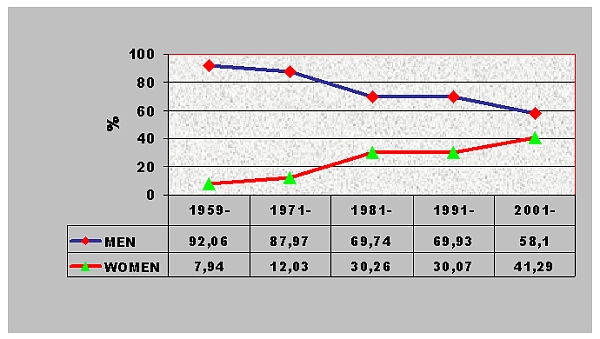
Figure 2. Increasing females’ percentage indicators
It is very important to mention that from the second part of the
seventies, much more women than usually began to study and especially
concentrating to non-traditionally female fields, as it happened with
surveying science.
2.2 The Years of Changes
In the beginning of the next decade (eighties), it is the informatics’
revolution that changes the rules, and surveyors were the first engineers
that involved with computers’ use. They began use them in their diary
activities, and done the calculations faster and easier.
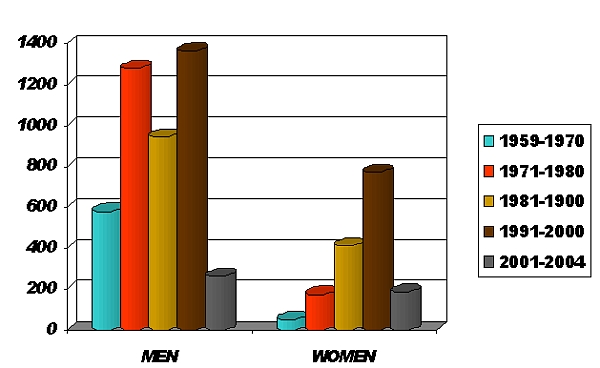
Figure 3. Actual members of graduates
New technologies changed the rules in photogrammetry, introduced the
digital photogrammetry, the remote sensing methods, the GIL/LIS, and of
course the management of all these masses of data. Even the geodetic
instruments became modern, faster and less heavy than in the past (total
stations, GPS). The two technical universities followed the changes and
they offered to the students (in time) all the necessary education to be
“modern engineers”, in the beginning of the 21st century. So year-to-year
the profile of the Greek Surveyor changed and also changed the market
demands and the necessary skills. The last decade (nineties) is marked
with the beginning of the implementation of the Hellenic Cadastre, which
based in a lot of new kind of works for the Greek market, and in use of
the most modern techniques. It is noticed that the majority of the
surveyors having a responsible position, in sub-projects were young women,
well educated and with special female skills, necessary for all those
complicated works. A surveyor now has to spend more time for processing
and manage data than product data in the fieldwork.
Traditionally, in the same time that men were at the field works, women
were in the office and in support works. In the past this was a
disadvantage, but women working at the office had the sense to understand
immediately all the advantages that new technologies were given. They also
became the “mothers spirit” of the companies and they developed their
managerial abilities. It is proved that they had a special skill to
combine the cadastral data (topographic data, legal issues, special local
conditions, communication with citizens and authorities, develop solutions
etc). As the most women involved with new technologies to give better
opportunities to their professional position, the new technologies have
accepted faster from the surveyor professionals. This was a two-way
development between females and profession. It seems that surveyor
engineers lead now in this field in Greece and this is something that
can’t be changed. Many ladies are now very successful professionals
(owners of companies, managers, academics, directors etc.), and this
creates an attractive image of the female surveyor that encourages more
and more young girls to choose this field of studies.
3. Success of Fifty-Fifty
As it is analyzed above, all the factors direct to the total
convocation of the percentages numbers representing the two genders. We
can propose the following actions to guide on it:
- Total adaptation of new technologies at the universities’ plans,
although in Greece studies in technical universities are already very
good.
- Amelioration of the social supply for the woman who works.
Concluding we talk about a modern profession that can be a “two genders
profession”, with a lot of opportunities and that offers the necessary
flexibility to follow the new incomes, in a world that walks with big
steps.
Eleni Tziortzioti and Anna Karagiannaki, H.A.R.S.E.
(Hellenic Association of Rural and Surveying Engineers)
e-mail: ltzio@dpols.minenv.gr ;
diodos-m@otenet.gr
Collaboration with Gender and
Cartography Commission
By Gabriele Dasse
Prof. Ewa Krzywicka-Blum, Chair of the ICA (International
Cartographic Association) Gender and Cartography Commission would like to
enlarge the collaboration between the Gender and Cartography Commission
and the Working Group on Under-represented Groups in Surveying. The
proposal is, to exchange basic information concerning actually realized
projects, workshops and meetings.
1. During last four years a Socio-Demographic Atlas of Poland
illustrating chosen problems of under-represented subpopulations
(minorities, single mothers) and users with special cartographic needs
(the blind, emigrants, pupils, sportsmen) was prepared. Some pages of the
Atlas are accessible on
http://www.geo.ar.wroc.pl/GC/atlas/ica_atlas.html. The ICA Gender and
Cartography Commission wants to promote the production of gender issues
oriented atlases of various regions of the world by encouraging various
institutions and organizations to prepare atlases similar to the Polish
Atlas.
Question:
Is it possible to include such an initiative to the activity of FIG?
2. For 2003-2007 the ICA Gender and Cartography Commission wants to
prepare guidelines and specifications for mapping of issues related to
gender and under-represented groups at regional and global levels.
Question:
Is it possible to cooperate in this field?
I am looking forward to getting your remarks and some new ideas.
For more information about the Gender and Cartography Commission visit
the website
http://www.geo.ar.wroc.pl/GC/. For the ICA Gender and Cartography
Commission it is interesting to enlarge the list of Women in Cartography
to Women in Cartography, Geography and Geodesy.
Gabriele Dasse
e-mail: g.dasse@gmx.de
American Accreditation Board
Strives for Diversity
By Wendy J.W. Straight, United States
ABET is an accreditation organization based in the United States. Until
recently, it was known as the Accreditation Board for Engineering and
Technology. ABET provides an internationally recognized mechanism through
which a number of associate-level and baccalaureate-level surveying
programs are evaluated in the United States.
Programs may apply to ABET for accreditation, at which time the review
process begins. Evaluation may take place over the next one to two years,
and accreditation periods may extend up to six years.
The issue of diversity in education will be a topic of four sessions at
the October, 2004 annual meeting of ABET. “The changing face of the
United States workforce, the evolving international practices of
employers, and the shifting of technology and jobs around the world, are
all matters of increasing concern stemming from the globalization of the
economy,” ABET said.
“While globalization in many ways continues to benefit our fields,
it has created challenges as well,” ABET continued. In one of the
sessions, industry leaders will discuss the knowledge, skills, and
attitudes they seek in their employees, talents that allow employers to
retain their competitive edge in the marketplace.
With respect to the university environment in America, ABET said, “There
are more women and minorities seeking a college education than ever
before. The non-traditional or remote student is beginning to outnumber
traditional students in some disciplines. Foreign students increasingly
dominate graduate and postgraduate studies in many fields.”
Therefore, another upcoming session at the annual ABET meeting will
include specific issues such as changes in pedagogy, the retention of
diverse student populations, and creative initiatives for diverse
learners.
Diversity is also an issue among professional associations. “Many of
the technical and professional societies in the ABET disciplines are
struggling to increase membership and to retain their current members,”
ABET explained. “For many societies, the top concern is not simply a
matter of retaining and increasing membership, but rather of diversifying
membership to reflect the global workforce.
“Among ABET societies, diversifying at the leadership levels is a
top concern, as is supplying ABET with a diverse pool of program
evaluators, commissioners, and Board members.” In one of the upcoming
sessions, society representatives will discuss challenges they face, and
the best practices they have found so far.
The fourth session will address ABET policy itself. “Many United
States accrediting bodies are beginning to address the issues related to
diversity in the accreditation of educational institutions and programs,”
ABET continued. “There are questions, however, concerning the role that
accrediting bodies should play in the issue of diversity.”
As an accreditor, ABET has at least three options to be discussed. (1)
ABET could indirectly support a program’s endeavors toward diversity
enhancement. (2) ABET could create a set of recommended guidelines for
programs to follow. (3) ABET could add accreditation criteria to address
diversity directly.
Gathering input on these three options will be a goal of the October
discussions. Other accreditation bodies will also be involved. Detailed
session descriptions are available at
www.abet.org/annual_meeting_cover.html.
Wendy J.W. Straight, Professional Land Surveyor
e-mail: wendy@netsync.net
Elizabeth Ann Johnson was a Leader
in Diversity
Contributed by Dr. Herbert Stoughton, United States
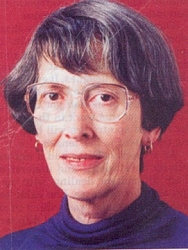 The
April, 2004 issue of Physic Today reported that Elizabeth Ann Johnson,
a contributor to several branches of theoretical physics and an advocate
for women in science and engineering, died at her home in Guildford,
England at age 67 last September after battling cancer for several years. The
April, 2004 issue of Physic Today reported that Elizabeth Ann Johnson,
a contributor to several branches of theoretical physics and an advocate
for women in science and engineering, died at her home in Guildford,
England at age 67 last September after battling cancer for several years.
A tribute to Johnson was written for PHYSICS TODAY by Angus
MacKinnon and John Pendry of Imperial College London. Johnson
was born in Philadelphia, Pennsylvania. She received a BA in physics and
mathematics from Swarthmore College in 1958 and then travelled to the UK
as a Fullbright fellow, where she pursued research at the University of
Manchester.
She completed her PhD there in 1961. Her thesis concerned symmetry
classification of the elementary particles. Her husband Ron is a
professor of theoretical physics at the University of Surrey, also in the
UK. Johnson conducted further research at Manchester as well as at the
University of Pittsburgh and the University of Wisconsin-Madison. Over the
years, she held positions at King’s College, the University of Auckland,
and the University of Surrey.
She was one of the first to obtain a fellowship from a fund set up by
Daphne Jackson in 1986, who was then the only female professor of
physics in the UK. The thrust of Jackson’s program was to enable women who
had taken a break from their science or engineering careers to resume
their research. Johnson was deeply committed to Jackson’s ideals. When
Daphne Jackson died, Elizabeth Johnson became a part-time coordinator of
the program.
Johnson divided her time between her physics research and the Daphne
Jackson Memorial Fellowships Trust. “Johnson was also instrumental in
setting up Portia, a Web site that provides a gateway for women into
science, engineering, and technology,” said MacKinnon and Pendry.
Johnson also created the Daphnet mailing list for women in those fields.
Johnson’s work in physics evolved into research on inelastic scattering
processes in quantum transport and spin-dependent effects in
semiconductors. In her theoretical research, she also attempted to predict
effects in real materials. “We benefited from her insights based on her
broad experience in different research fields, and from her expansive
network of contacts,” said MacKinnon and Pendry. “The fruits of her
work in the emerging field of spintronics will be a lasting testament to
her tenacity.”
Even during her years of chemo- and radio-therapy, Johnson continued
her research. She was also an accomplished pianist, organist, and
composer. Queen Elizabeth appointed Johnson a Member of the Order of the
British Empire in 2002. The University of Bath awarded her an honorary
doctorate posthumously. “We remember her with great affection as a
scientist,” MacKinnon and Pendry said. “Unfailingly courteous and
cheerful even in sickness, she served as a splendid inspiration to us. She
leaves a gap in our lives.”
|
Editor: Chair of the Joint Commission Working Group
on Under-represented Groups in Surveying
Ms. Gabriele Dasse,
Kleinfeld 22 a, D-21149
Hamburg, Germany
E-mail: g.dasse@gmx.de
3/04, month of issue:
July
© Copyright 2004 Gabriele Dasse.
Permission is granted to photocopy in limited quantity for educational
purposes.
Other requests to photocopy or otherwise reproduce material
in this newsletter should be addressed to the Editor.
|
|





























 The
April, 2004 issue of Physic Today reported that Elizabeth Ann Johnson,
a contributor to several branches of theoretical physics and an advocate
for women in science and engineering, died at her home in Guildford,
England at age 67 last September after battling cancer for several years.
The
April, 2004 issue of Physic Today reported that Elizabeth Ann Johnson,
a contributor to several branches of theoretical physics and an advocate
for women in science and engineering, died at her home in Guildford,
England at age 67 last September after battling cancer for several years.